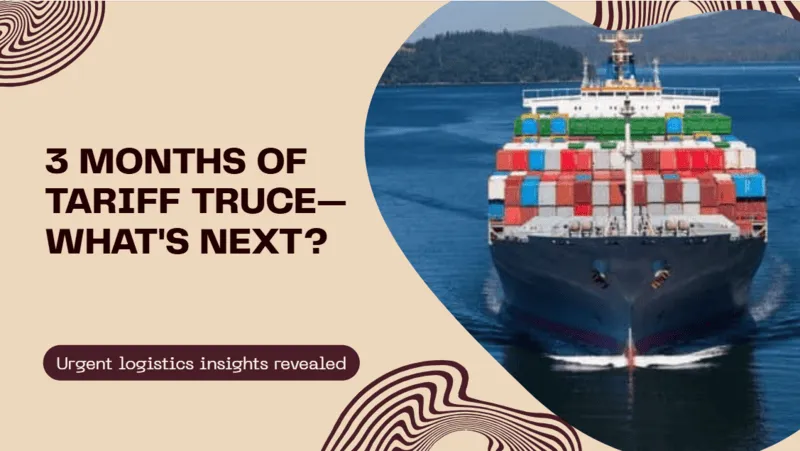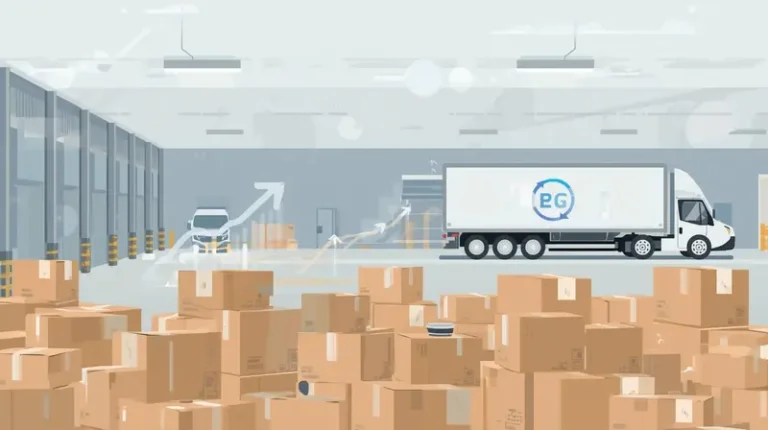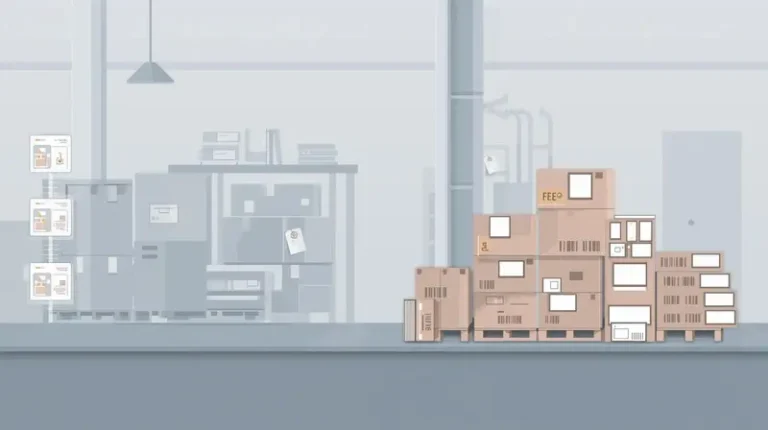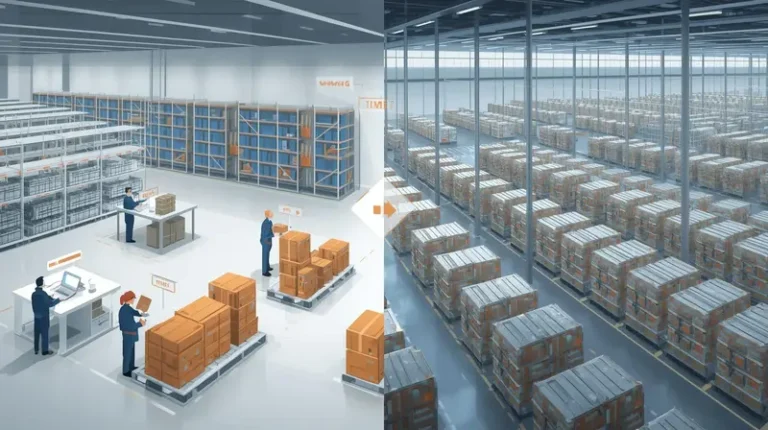US-China Tariff Truce: 3 More Months of Calm, Then What? Why Brands Can’t Rely on The Pause Button

Last updated on August 15, 2025

In this article
 7 minutes
7 minutes
- Temporary Relief ≠ Permanent Solution
- Geopolitical Tariffs = Unpredictable Policy Levers
- Waiting Costs More Than the Tariff Hits
- Stabilize Your Supply Chain, Don’t Wait for Markets to Stabilize You
- Why This Matters to Your Ecommerce Business
- Quick Tactical Takeaways
- Final Thought
- Frequently Asked Questions
The U.S.–China tariff truce has been extended. Sweet relief, right? But here’s the harsh truth: the pause is temporary. The United States and China, the world’s two largest economies, have only agreed to a brief halt in their ongoing trade tensions. If you’re just leaning back, hoping for stabilization, you’re risking profit erosion.
Let’s talk straight: waiting for diplomacy to bail you out isn’t a strategy. It’s a gamble. And in ecommerce logistics, the house always wins.
Temporary Relief ≠ Permanent Solution
So here’s what’s happening. On August 12, 2025, President Donald Trump signed an executive order extending the tariff truce with China by another 90 days, pushing the deadline out to November 10. This move effectively extends the China tariff deadline, giving negotiators more time to reach an agreement.
Without this extension, tariffs on Chinese imports were poised to spike to 145%, and China’s retaliatory duties on U.S. exports could have hit 125%. Instead, current rates, around 30% for U.S. tariffs on Chinese goods and 10% for China’s on U.S. goods, will stay put… for now.
But let’s be clear: a pause is not the same as peace. Markets cheered, inventories flowed, and the immediate threat looked defused. Yet the underlying uncertainty? Multiplying, as the tariff truce deadline now looms over future trade relations and negotiations.
Slash Your Fulfillment Costs by Up to 30%
Cut shipping expenses by 30% and boost profit with Cahoot's AI-optimized fulfillment services and modern tech —no overheads and no humans required!
I'm Interested in Saving Time and MoneyGeopolitical Tariffs = Unpredictable Policy Levers
This isn’t just trade. It’s geopolitics. Tariffs now function as negotiation chips, used to sway behavior on purchases of Russian oil, chip exports, and rare earth minerals, and are often paired with export controls and export restrictions by both the US and China. That makes them volatile, flexible, and totally unreliable.
If your ecommerce logistics strategy is rooted in cost-only supply chains, long lead times, single-region sourcing, and minimal fulfillment centers, they’re brittle. When policy shifts, you’re stuck.
Meanwhile, think about global players like Lenovo. They called the extension a “positive situation”, but it barely moved the needle. Tariffs stayed at 30%, and their diversified manufacturing + local components, along with strategies to navigate technology restrictions, guarded them from real damage.
This is your blueprint: build logistics agility so strong that policy whiplash doesn’t leave you limping.
Waiting Costs More Than the Tariff Hits
KAVU learned this the hard way, delaying layoffs and price hikes until tariffs hit hard. Thousands of brands will repeat this mistake. They’re buying inventory now, hoping the truce lasts. But in Q4, when rates rise, they’ll scramble to preserve margins. And by then? It’s too late. Tariffs on American goods have made it harder for US brands to compete internationally, directly impacting the competitiveness of American exports. The current truce provides only temporary relief for exporters, who remain vulnerable to future policy changes.
The invisible cost of waiting: lingering profit erosion, last-minute air-freight spikes, poor customer satisfaction, and delayed order fulfillment. That’s a nasty combo, especially when customer expectations demand fast, affordable shipping. The broader economic impact of these tariffs is significant, with the trade deficit being a key concern driving US trade policy and negotiations.
Smart brands won’t just weather a truce; they’ll use it to eliminate tariff exposure altogether by deploying node-based fulfillment, dynamic routing, and shipping automation through networks like Cahoot.
Stabilize Your Supply Chain, Don’t Wait for Markets to Stabilize You
Here’s how to lean in, right now:
- Audit your tariff exposure SKU by SKU. Map high risk zones and build a flex-forward fulfillment strategy.
- Expand your fulfillment network. Set up multiple distribution centers, peer-to-peer nodes, regional carriers, so your logistics infrastructure is elastic, not rigid. Work with a range of trade partners to reduce risk and ensure continuity. Building relationships with diverse trading partners is key to a resilient supply chain.
- Automate shipping with Cahoot. Use software-based routing, carrier switching, dynamic warehouse management system logic, so when policy shifts, your logistics operations adjust in real time.
- Don’t chase lowest-cost sourcing. Add buffer costs for flexibility. Diverse suppliers mean lower risk when tariffs hit hard. That’s modern ecommerce supply chain management in action.
- Model worst, moderate, best-case scenarios, and update weekly. A truce extension might blow through, or courts might reinstate tariff authority.
Looking for a New 3PL? Start with this Free RFP Template
Cut weeks off your selection process. Avoid pitfalls. Get the only 3PL RFP checklist built for ecommerce brands, absolutely free.
Get My Free 3PL RFPWhy This Matters to Your Ecommerce Business
The U.S.–China tariff truce is more than a political headline. It’s a wake-up call for ecommerce business owners, logistics partners, and fulfillment center operators who rely on stable sourcing and delivery flows. These trade tensions have significant implications for the global economy, affecting international markets and financial stability. Understanding these challenges through the lens of international economics is crucial for navigating the complexities of global supply chains and adapting to shifting trade policies.
As shipping costs climb, inventory management grows more complex, and fulfillment process agility becomes a survival skill, you’ll need to optimize last mile delivery, manage reverse logistics crisply, and shield customer experience from political shocks.
If your logistics strategy stays defensive, waiting for global calm, you’re not resilient. You’re reactive. And by Q4, reactive means losing margins, firing frantic actions, and disappointing customers.
Quick Tactical Takeaways
- The 90-day tariff truce buys time, not opportunity. Use it to build for uncertainty, as there is a risk of higher tariffs returning once the truce ends.
- Tariffs are a geopolitical lever, not just trade policy. Unpredictable trade policies can drive volatility, so prepare accordingly.
- Build logistics flexibility today. Node-based, automated, multi-region fulfillment is non-negotiable.
- Waiting erodes profits and trust. Protect Q4 margins now by investing in agile logistics infrastructure.
- Cahoot can be your edge: peer fulfillment, shipping automation, smart routing. Use it to out-flex policy.
Final Thought
Most brands will sit tight, hoping tariffs disappear on their own. But here’s the real play: disappear from tariff exposure altogether, not by wishing, but by building a logistics system so agile, flexible, and automated that policy shifts don’t derail you.
The truce is temporary, but your resilience doesn’t have to be.
Scale Faster with the World’s First Peer-to-Peer Fulfillment Network
Tap into a nationwide network of high-performance partner warehouses — expand capacity, cut shipping costs, and reach customers 1–2 days faster.
Explore Fulfillment NetworkFrequently Asked Questions
What is the U.S.–China tariff truce?
The U.S.–China tariff truce is a temporary agreement between the world’s two largest economies to pause additional tariff hikes on Chinese imports and U.S. exports. It buys time for trade negotiations but does not roll back existing tariff rates, which remain as high as 30% on certain Chinese goods.
How long is the current tariff truce extension?
The latest extension, signed by President Donald Trump on August 12, 2025, lasts 90 days, until November 10, 2025. After that, tariffs could increase significantly if no new trade deal is reached. Unlike the earlier phase one agreement, which included specific commitments from China to purchase US goods and set clear terms on tariffs, the current truce lacks detailed purchase targets and leaves more issues unresolved.
Why is relying on a tariff truce risky for ecommerce businesses?
A tariff truce is not a permanent solution. Tariffs are being used as geopolitical tools, often driven by economic security concerns and national security considerations. Brands that delay logistics upgrades risk sudden cost spikes, supply chain disruptions, and eroded profit margins.
How can ecommerce brands prepare during a tariff suspension?
Use the pause to diversify sourcing, expand fulfillment networks, automate shipping processes, and secure multiple distribution centers. These steps create agility in the supply chain, reducing dependence on any single trade outcome, including the potential reinstatement of reciprocal tariffs.
What’s the biggest mistake ecommerce businesses make during a trade truce?
The most common mistake is inaction, waiting for tariffs to disappear instead of building resilience. These tariffs are often a response to unfair trade practices, such as subsidies, import quotas, and export restrictions, which contribute to trade tensions between the US and China. In the context of the ongoing trade war, by the time tariffs resume, it’s often too late to protect Q4 margins or meet customer expectations for fast, cost-efficient delivery.

Turn Returns Into New Revenue





